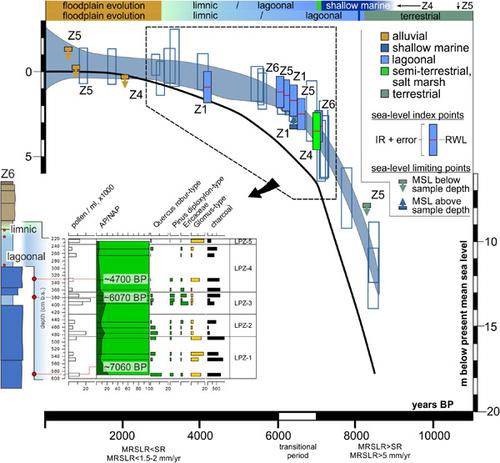当前位置:
X-MOL 学术
›
Geoarchaeology
›
论文详情
Our official English website, www.x-mol.net, welcomes your
feedback! (Note: you will need to create a separate account there.)
Mid- to late Holocene environmental changes and human-environment interactions in the surroundings of La Silla del Papa, SW Spain
Geoarchaeology ( IF 1.4 ) Pub Date : 2021-02-17 , DOI: 10.1002/gea.21846 Simon M. May 1 , Maike Norpoth 1 , Anna Pint 1 , Lyudmila Shumilovskikh 2, 3 , Kira Raith 4 , Dominik Brill 1 , Gilles Rixhon 5 , Pierre Moret 6 , Helena Jiménez‐Vialás 6, 7 , Ignasi Grau‐Mira 8 , Iván García‐Jiménez 9 , Dirce Marzoli 10 , César León‐Martín 10 , Klaus Reicherter 11 , Helmut Brückner 1
Geoarchaeology ( IF 1.4 ) Pub Date : 2021-02-17 , DOI: 10.1002/gea.21846 Simon M. May 1 , Maike Norpoth 1 , Anna Pint 1 , Lyudmila Shumilovskikh 2, 3 , Kira Raith 4 , Dominik Brill 1 , Gilles Rixhon 5 , Pierre Moret 6 , Helena Jiménez‐Vialás 6, 7 , Ignasi Grau‐Mira 8 , Iván García‐Jiménez 9 , Dirce Marzoli 10 , César León‐Martín 10 , Klaus Reicherter 11 , Helmut Brückner 1
Affiliation

|
In southern Iberia, the surroundings of the Strait of Gibraltar are known as a crossroad for population movements, cultural exchanges, and trade from Late Prehistory to modern times. However, questions remain about the impact of this historical development on the environment. The settlement of La Silla del Papa, an important hillfort in southern Andalusia (Cádiz), was occupied during the entire Iron Age, replaced by the coastal town Baelo Claudia during Roman times, and re-occupied during Early Medieval times. As such, La Silla del Papa and its territory represent an ideal location for long-term studies on human-environment interactions. Within the framework of the interdisciplinary project “Archeostraits,” geoarchaeological investigations in the surroundings of La Silla del Papa aimed at constraining ecological conditions and human-environment interactions during the mid- and late Holocene and during major human occupation phases. Our results document an early mid-Holocene marine embayment in the lower floodplain of the Río del Cachón, rapidly turning into a coastal lagoon and later into freshwater-dominated wetlands. After approximately 2100 BP (c. 150 BC), fluvial and alluvial deposition i600ing a high anthropogenic impact on the local landscape during Roman or post-Roman times. Palynological results reveal fluctuating agricultural and pastoral activities and distinct periods of landscape opening during the Neolithic and Iron Age.
中文翻译:

西班牙西南部 La Silla del Papa 周边全新世中晚期环境变化与人地相互作用
在伊比利亚南部,直布罗陀海峡周围地区被称为从史前晚期到现代的人口流动、文化交流和贸易的十字路口。然而,这一历史发展对环境的影响仍然存在疑问。La Silla del Papa 定居点是安达卢西亚南部(加的斯)的一个重要山丘堡垒,在整个铁器时代都被占领,在罗马时期被沿海城镇 Baelo Claudia 取代,并在中世纪早期重新被占领。因此,La Silla del Papa 及其领土是长期研究人类与环境相互作用的理想场所。在跨学科项目“Archeostraits, ” La Silla del Papa 周边地区的地质考古调查旨在限制全新世中晚期和人类主要占领阶段的生态条件和人类与环境的相互作用。我们的结果记录了 Río del Cachón 下游洪泛区中全新世早期的海洋海湾,迅速转变为沿海泻湖,后来转变为以淡水为主的湿地。在大约 2100 BP(公元前 150 年)之后,河流和冲积物沉积对罗马或后罗马时代的当地景观产生了高度的人为影响。孢粉学结果揭示了新石器时代和铁器时代农业和牧区活动的波动以及景观开放的不同时期。我们的结果记录了 Río del Cachón 下游洪泛区中全新世早期的海洋海湾,迅速转变为沿海泻湖,后来转变为以淡水为主的湿地。在大约 2100 BP(公元前 150 年)之后,河流和冲积物沉积对罗马或后罗马时代的当地景观产生了高度的人为影响。孢粉学结果揭示了新石器时代和铁器时代农业和牧区活动的波动以及景观开放的不同时期。我们的结果记录了 Río del Cachón 下游洪泛区中全新世早期的海洋海湾,迅速转变为沿海泻湖,后来转变为以淡水为主的湿地。在大约 2100 BP(公元前 150 年)之后,河流和冲积物沉积对罗马或后罗马时代的当地景观产生了高度的人为影响。孢粉学结果揭示了新石器时代和铁器时代农业和牧区活动的波动以及景观开放的不同时期。
更新日期:2021-02-17
中文翻译:

西班牙西南部 La Silla del Papa 周边全新世中晚期环境变化与人地相互作用
在伊比利亚南部,直布罗陀海峡周围地区被称为从史前晚期到现代的人口流动、文化交流和贸易的十字路口。然而,这一历史发展对环境的影响仍然存在疑问。La Silla del Papa 定居点是安达卢西亚南部(加的斯)的一个重要山丘堡垒,在整个铁器时代都被占领,在罗马时期被沿海城镇 Baelo Claudia 取代,并在中世纪早期重新被占领。因此,La Silla del Papa 及其领土是长期研究人类与环境相互作用的理想场所。在跨学科项目“Archeostraits, ” La Silla del Papa 周边地区的地质考古调查旨在限制全新世中晚期和人类主要占领阶段的生态条件和人类与环境的相互作用。我们的结果记录了 Río del Cachón 下游洪泛区中全新世早期的海洋海湾,迅速转变为沿海泻湖,后来转变为以淡水为主的湿地。在大约 2100 BP(公元前 150 年)之后,河流和冲积物沉积对罗马或后罗马时代的当地景观产生了高度的人为影响。孢粉学结果揭示了新石器时代和铁器时代农业和牧区活动的波动以及景观开放的不同时期。我们的结果记录了 Río del Cachón 下游洪泛区中全新世早期的海洋海湾,迅速转变为沿海泻湖,后来转变为以淡水为主的湿地。在大约 2100 BP(公元前 150 年)之后,河流和冲积物沉积对罗马或后罗马时代的当地景观产生了高度的人为影响。孢粉学结果揭示了新石器时代和铁器时代农业和牧区活动的波动以及景观开放的不同时期。我们的结果记录了 Río del Cachón 下游洪泛区中全新世早期的海洋海湾,迅速转变为沿海泻湖,后来转变为以淡水为主的湿地。在大约 2100 BP(公元前 150 年)之后,河流和冲积物沉积对罗马或后罗马时代的当地景观产生了高度的人为影响。孢粉学结果揭示了新石器时代和铁器时代农业和牧区活动的波动以及景观开放的不同时期。











































 京公网安备 11010802027423号
京公网安备 11010802027423号